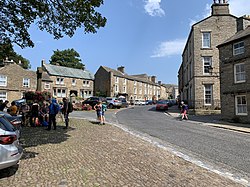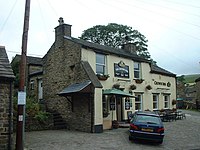Askrigg
| Askrigg | |
| Yorkshire North Riding | |
|---|---|
 Askrigg | |
| Location | |
| Grid reference: | SD948910 |
| Location: | 54°18’54"N, 2°4’52"W |
| Data | |
| Population: | 563 (2011) |
| Post town: | Leyburn |
| Postcode: | DL8 |
| Local Government | |
| Council: | Richmondshire |
| Parliamentary constituency: |
Richmond (Yorks) |
Askrigg is a small village in Wensleydale in the North Riding of Yorkshire, and within the Yorkshire Dales National Park.
The village is located in Upper Wensleydale, twelve miles west of Leyburn, and five miles east of Hawes.
The name 'Askrigg' is of Old Norse origin, from askr ('ash tree') and hryggr ('ridge').[1][2]
Contents
Churches
The parish chirch is St Oswald's Church. It was erected about 1466. The church is a Grade I listed building.[3] It is of stone construction in the Perpendicular style, consisting of chancel, nave, aisles, south porch and an embattled western tower with pinnacles containing a clock and six bells.[4][5]
There was a Wesleyan Methodist chapel here, erected in 1878 on the site of a former chapel. Subsequently, known as Bottom Chapel, it was run as a bed and breakfast before becoming a private dwelling. The Primitive Methodists also built a chapel in the village in 1869 as part of the Middleham Circuit.[4][5]
History
The oldest settlement by Askrigg probably dates back to the Iron Age.
That Norse settlers farmed here is evidenced by the village's name. The village is mentioned in the Domesday Book as Ascric.[6] At the time of the Norman invasion the manor was held by Arnketil. Afterwards the lands were owned on behalf of the Crown by Count Alan of Brittany who granted then lordship of the manor to Gospatric, son of Arnketil. By 1251 the manor had come to the Fitz Hugh family who were also lords of Ravenworth and stayed with them until the 16th century.
The village remained of little commercial importance throughout the 13th and 14th centuries when Wensleydale was extensively used for sheep grazing by the Cistercian monks, who became prosperous on the profits of the wool trade. In the 15th and 16th centuries, however, secular wealth became important in the dale following the border conflicts in the north and the Dissolution of the Monasteries throughout the country.[7]
In the early 16th century the manor became the possession of Sir Thomas Parr. His son William died without issue in 1571 when it became the property of the Crown. In 1664 the manorial rights were leased from the Crown by the Metcalfe family.[4][5]
Askrigg was granted a Charter by Elizabeth I in 1587 for the holding of a weekly market on Thursday, and of fairs in spring, summer and autumn. Askrigg's prosperity peaked in the 18th century when trade in textiles and knitting was most lucrative and the village supported many craftsmen and gained a reputation for clockmaking. The earliest mention of Askrigg clockmakers was of a a Quaker named John Ogden, who moved to Askrigg in 1680 and manufactured his clocks there until 1720. He was succeeded by Mark Metcalfe (1687–1776) and Christopher Caygill (1747–1803). Another well-known clockmaker was James Pratt (1787–1850). All three had sons who were also clockmakers. Two 19th century clockmakers were John Stancliffe and John Skidmore.[8]
Askrigg was the home of the Wensleydale Metcalfe family who lived at nearby Nappa Hall. Mary, Queen of Scots, was once imprisoned in the house, possibly before she was moved to Castle Bolton further down the dale.
Askrigg became a junction of two turnpikes; the first, the Richmond to Lancaster Turnpike, was sent through the village in 1751. A diversion through the then hamlet of Hawes in 1795, meant that the market at Askrigg fell into decline as Hawes became the last coaching stop in Wensleydale before going over into Ribblesdale.[9] In 1761, the turnpike to Sedbergh was started.[10]
Askrigg has a market cross erected in 1830, a stone pump and an iron bull ring set into the cobbles. The bull ring dates from the 18th century and earlier, when bulls would be tied here and then attacked or baited with dogs. A local historian wrote that "it used to be a custom in Askrigg for a man who wanted to fight to go and turn the bull ring over; if another man was feeling the same, he came and turned it back and they had a fight."[7]
Inns
One of the local pubs, the Crown Inn, has been known under this name since the 1850s and there has been an inn at this site since the late 18th century. The other pub, the Kings Arms, was built in 1767 as a coaching inn by John Pratt, a local who had made a fortune as a jockey. Pratt was a racehorse breeder and master of the Askrigg Harriers during the 18th century. He kept his hunters and pack of hounds in a yard behind the house he built on Askrigg's main street in 1767. The kennels and stabling date to the late 18th or early 19th century. The kennels had a semi-circular enclosure attached and the long row of stabling lay beyond. Pratt's hunters were ridden in and out of his land through Robinson's Gateways on the main street. The site has now been restored to provide holiday accommodation.[7]
Railway
The village once had a railway station that was part of the Hawes Branch of the North Eastern Railway from its opening in 1878 to its closure in April 1954. The Wensleydale Railway Association has plans to rebuild the railway from Northallerton (from its current western terminus at Redmire) to Garsdale including the re-opening of the station in the village. This had been planned for since 2005,[11] but due to spiralling costs, the railway is focussing on reaching only Castle Bolton initially from Redmire.[12]
Community and culture
Education in the village is provided at Askrigg VC Primary School. The school occupies part of the building formerly housing the Yorebridge Grammar School.[13]
At the western end of the village is the Yorebridge Sports Development Association. It has a multi use games area that can be used for Football, Tennis, Basketball and Netball, and there is also a Gymnasium with a Fitness Centre.[14] At Low Mill there is an Outdoor Activities Centre established in 1976.[15] Askrigg has three pubs, a village bakery with delicatessen, two tea rooms, a village shop, and newsagents. There are also a number of Bed & Breakfast establishments.[16]
On television
The village has become notable through its role as the fictional Darrowby in the BBC Television series All Creatures Great and Small. Cringley House, which doubled as the exterior of Skeldale House in the series, is now a bed and breakfast.[17] (The real Darrowby of the books was Thirsk.)
The King's Arms Hotel doubled as the Drover's Arms in the television series All Creatures Great and Small[17]
About the village
- St Oswald's Church
Nappa Hall: a Grade I listed building.[18] It is a 15th-century fortified manor house built in 1459 by James Metcalfe and his son Sir Thomas Metcalfe at a time when there were frequent raids by the Scots.
- Ring Cairn, Force Ing, west of Whitfield Gill: a ring cairn, which is a circle of stones that surround a depression on the ground and could signify a prehistoric burial site. It is a Scheduled Ancient Monument.[19]
- Ring Cairn near Church: a Bronze Age ring cairn that today survives as an earthwork, and a Scheduled Ancient Monument.[20]
- Mill Gill Force: a spectacular waterfall about three-quarters of a mile to the north-west of the village, where the Mill Gill plunges about 25 feet into a steep rocky ravine hidden in woodland. The waterfall can be reached by an easy 15 minutes walk from the village centre, the footpath is waymarked.
Pictures
Outside links
| ("Wikimedia Commons" has material about Askrigg) |
References
- ↑ Watts (2011). Cambridge Dictionary of English Place-names. Cambridge University Press. p. 23. ISBN 978-0521168557.
- ↑ Mills, A.D. (1998). Dictionary of English Place-Names. Oxford Paperbacks. p. 22. ISBN 978-0192800749.
- ↑ Church of St Oswald, Askrigg - British Listed Buildings
- ↑ 4.0 4.1 4.2 History
- ↑ 5.0 5.1 5.2 Bulmer's Topography, History and Directory (Private and Commercial) of North Yorkshire 1890. S&N Publishing. 1890. p. 338. ISBN 1-86150-299-0.
- ↑ Askrigg in the Domesday Book
- ↑ 7.0 7.1 7.2 Hartley, Marie; Ingilby, Joan (1953). Yorkshire Village. London: J. M. Dent & Sons. ISBN 978-0460044257.
- ↑ "The Clockmakers of Askrigg-Wensleydale". The Dales. 25 February 2006. Archived from the original on 11 December 2011. https://web.archive.org/web/20111211135145/http://www.thedales.org.uk/TheClockmakersOfAskrigg-Wensleydale. Retrieved 15 March 2012.
- ↑ "Out of Oblivion: A landscape through time". http://www.outofoblivion.org.uk/record.asp?id=418. Retrieved 8 July 2019.
- ↑ "Yorkshire Milestones". https://www.yorkshire-milestones.co.uk/index.php?option=com_content&view=article&id=70:the-sedbergh-turnpike-trust-and-its-milestones&catid=1755:all-about-milestones&Itemid=61. Retrieved 8 July 2019.
- ↑ Jeeves, Paul (10 June 2005). "Yorkshire Post: Railway launches GBP100,000 appeal". Newsbank (The Yorkshire Post). https://infoweb.newsbank.com/apps/news/document-view?p=AWNB&t=favorite%3AYorkshirePost%28England%29%21Yorkshire%20Post%20%28England%29&sort=YMD_date%3AD&page=5&fld-base-0=alltext&maxresults=20&val-base-0=Wensleydale%20railway&docref=news/10AAB49B15FC3692. Retrieved 1 April 2019.
- ↑ "One of Yorkshire’s best-loved railways back on right track for future after station sale decision". The Yorkshire Post. 25 March 2018. https://www.yorkshirepost.co.uk/news/one-of-yorkshire-s-best-loved-railways-back-on-right-track-for-future-after-station-sale-decision-1-9080448. Retrieved 1 April 2019.
- ↑ "Primary School Info". Archived from the original on 11 February 2012. https://web.archive.org/web/20120211082038/http://www.askrigg.n-yorks.sch.uk/information.htm. Retrieved 26 March 2013.
- ↑ "Sports Centre". http://www.yorebridgesports.btck.co.uk/AboutUs. Retrieved 26 March 2013.
- ↑ "Outdoor Activities". http://www.lowmill.com/index.php. Retrieved 26 March 2013.
- ↑ "Amenities". Archived from the original on 9 December 2012. https://web.archive.org/web/20121209033740/http://www.askrigg.org/askriggvillage.html. Retrieved 26 March 2013.
- ↑ 17.0 17.1 Welcome to Yorkshire: The King's Arms, Askrigg
- ↑ Nappa Hall, Askrigg - British Listed Buildings
- ↑ National Heritage List 1010538: Ring cairn on Force Ing, west of Whitfield Gill
- ↑ National Heritage List 1010539: Ring cairn west of Askrigg church







